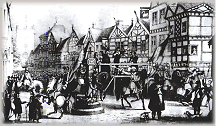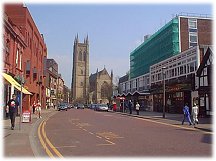
Churchgate Market (1251 - 1865)

The
old part of Bolton, where markets were first established, was built on a good
defensive site, as it was raised and bounded by rivers.
Early settlers appreciated the protection offered by these physical
features, and it is upon this site that the Parish Church was built as a visible
symbol and centre of a new community. The
present Parish Church is a relatively modern building, as evidence uncovered
during the demolition of the old Parish Church (c. 1870) shows that at least two
stone churches of an earlier date had existed on the same site.
Evidence
of the foundation of the market is scant, but Bolton obtained its Market Charter
in 1251. It is possible, though,
that the market operated even before this date.
The Charter was granted by King Henry III to William de Ferrars, Earl of
Derby, part of which reads:
“We
grant to the said Earl also and to his heirs forever, permission to hold a
market at this aforesaid manor of Bowelton, in the County of Lancaster, every
seventh day; and also at the same place a fair once a year extending over three
days, that is to say on the eve and on the feast and on the morrow of the feast
of St Margaret the Virgin.”
In
the early days, the market was held in front of the Parish Church, but as Bolton
grew in size and population, the market extended along Churchgate, Deansgate,
and later “Windy Bank” (Bank Street) and Bradshawgate.
These four principal old streets met at a market cross which stood for
200 years, until it was replaced in 1786 by a larger one with circular stone
steps. On the cobble-stone market
also stood the old wooden stocks, with accommodation for two villains which
served as both a deterrent and a source of entertainment for market-goers.
In
the fifteenth century, Bolton was a small but slowly growing market town with a
population of approximately 2,000 over the whole of the Parish.
It
“was once a babe of a place astride a beautiful Croal Valley, with its very,
very old village church almost hidden in the trees at one end of the street, its
rough environs running steeply down the lush pastures through which the stream
trickled its way” (B.E.N. 10th October, 1952).
The half-yearly fairs for horses, cattle, and farm produce shows the
rural character of the town in those days, but the textile industry began to
grow, and during the succeeding century assumed such importance that Leland in
1588 wrote:
“Bolton
Upon-Moor market standeth most by cotton (really wool) and coarse yarns."
Cotton
manufacture was introduced about 1650 and in 1675 was thus described:
“Seated
on the R. Irwell, a fair, well-built town, with broad streets, hath a market on
Mondays, which is very good for clothing and provisions, and it is a place of
great trade for fustians*.”
* Fustian is a combination of flax and cotton
Bolton
slowly evolved into an “industrial” community, and in 1700 farmer-weavers
were greater in number than those who were simply farmers. Weaving therefore was initially taken up by the existing
rural population, supplementing their income, which was almost always at, or
below, subsistence level. During
the first half of the eighteenth century, the population rose to over 5,000 and
the textile industry was carried on throughout the town, in the houses and
cottages of the surrounding hamlets.
Due
to this early “industrial development”, Bolton and its market grew in
importance, attracting buyers from as far afield as Manchester. It provided an important outlet for local produce and cloth.
The market grew to such an extent that on market days the resulting
congestion necessitated the rerouting of the mail coaches in order to avoid
delay.
By
the end of the eighteenth century, Bolton had expanded greatly.
The town’s trade in woollens quickly died out, and Bolton took a
leading part in the cotton industry, brought about by Samuel Crompton’s
invention, and a general improvement in textile machinery.
Bolton
became the centre of the cotton industry, and the town’s population rose by an
average of 1,000 per year. This
increase put an intolerable strain on the already inadequate market provision,
which had extended its former boundaries until normal life of the town ceased to
function. The impact of this
population increase was intensified because it was an increasingly industrial
population, who were unable to be self-sufficient in many ways in which the
rural population had been. Therefore,
they required more and a wider variety of goods.
By
1826 the overspill had assumed such proportions that an alternative site had to
be found, and an area of land to the south side of Deansgate was designated as a
market square. This move was only
made possible by transferring market rights from the Lord of the Manor to
Trustees. N 1792, the leading
citizens of Bolton obtained an Act of Parliament enclosing the common land on
Bolton Moor, and authorising a group of Trustees to take over the streets and
general management of the town. The
Bolton Improvement Act laid the foundation of modern Bolton, and enabled the
Trustees to take over, in part, the management of market provision.
Trading
continued in Churchgate for some time after New Market Square was opened; this
and other spots were still authorised in 1850 for stalls and standings for meat,
poultry, grain, green groceries, fruit, hay, straw, boots, shoes, smallware,
medicines, confectionery, seeds, bacon, eggs, fish, ironmongery and all other
marketable goods. Churchgate
remained as the fish market until the opening of the Market Hall in 1855.
That
Churchgate was once the old market place is still clearly discernible.
The stocks have disappeared, and so too has the old cross, but the
original street pattern remains, though Bradshawgate has been widened
appreciably and, together with Bank Street, Churchgate and Deansgate, no longer
forms the centre of the town. A commemorative obelisk surmounted by a bronze cross, which
was given by a local benefactor, marks the spot of the market, and is inscribed
with a chronicle of outstanding events in the history of Bolton from 1253 to
1901, and serves as a reminder of Bolton’s past.

The Market Cross
Besides
serving as the market place, Churchgate was where Bolton’s most dramatic and
historic events were staged.
The
“Man and Scythe” pub in Churchgate is famed for its connection with the
execution of James, the 7th Earl of Derby, during the Civil War
between the Royalists and the Parliamentarians in the middle of the seventeenth
century. It was a war in which
Bolton and most of Lancashire played an important part. It was for his alleged participation in what has been called
the “Massacre of Bolton” and also for having “killed in cold blood one
Captain Boothe, formerly his servant”, that the Earl was condemned to die.
The scaffold was erected in the Market-place, Churchgate, in close
proximity to the Market Cross and opposite the “Man and Scythe”, where it is
believed he spent his last hours before being beheaded.
Also,
Churchgate witnessed many “remarkable” scenes amongst which the Chartists
have played their part, when the Monarchists and Republicans created disturbance
in the country at the time of the French Revolution. There were sections favouring both sides in Bolton.
Works by Thomas Paine, amongst them, the “Rights of Man”, were
circulated in the town, despite denunciation.
Towards the end of the eighteenth century, it is related that “… an
extraordinary scene was witnessed in the market-place, Churchgate, following
certain prosecutions of Republicans who had used, it was alleged, seditious
language. There was a huge assembly
in the market-place to see the effigy of Paine burned.
It was so placed that all who wished could see it.
Displayed on the body were the words the “Wrongs of Man” and on the
hat was the motto “Death to the disturber of Peace”.
The effigy was consumed, a chronicler writing that, “all was peace and
harmony”, the followers of Paine refraining on that occasion from giving vent
to their feelings. On the ashes of
the effigy were burned the books of Paine and similar literature which had been
amongst the stock of the Public Library Subscribers” (the Bolton Chronicle,
Saturday December 7th, 1912).
Also
Churchgate was, and remained for quite a while, the centre of Bolton’s
amusements. In the early days there
was a cockpit, and doubtless bull-baiting took place. The absence of licensing laws explains the proliferation of
establishments supplying good malt beer. Many
inns and taverns surrounded the market and some still remain, the “Man and
Scythe” being the oldest and one which serves as a picturesque reminder of old
Churchgate. The brutal pastimes of
early days were succeeded by theatres, music halls, museums and tea rooms, and
later cinemas and cafes.
Today,
most of the old buildings have disappeared and given place to modern buildings,
but besides the “Man and Scythe” there also remains Walsh’s Old Pastie
Shop (also a listed building).

Churchgate Today
Memories in Churchgate
“Farmers carts and wagons would be piled high with produce, there would be an occasional pig or litter of pigs for disposal; and most of the meat and mutton consumed in the town would be bred on the surrounding moorland homesteads … the space near the Market Cross would resound with their shouts and their laughter as they greeted and chivied each other … Their women folk, not less talkative and much more shrill and industrious than the men, sold their eggs, homemade butter and cheese. One can see them in their large aprons and huge sun bonnets urging the townsfolk to buy; some of the latter bringing in their muslins and rougher clothes to exchange for foodstuffs and everybody haggling for the best prices”.
(Bolton
Chronicle, 1870)
The above extract recalls Churchgate Market as it was before it was removed to New Market Square in 1826.